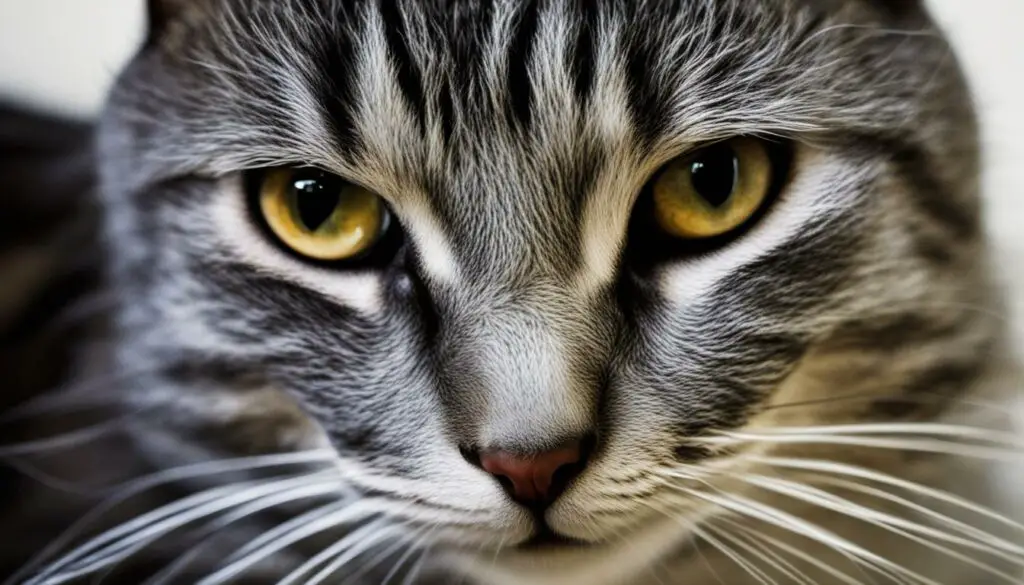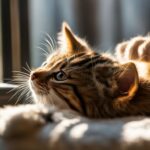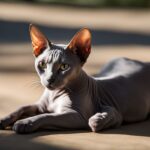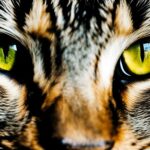I recently came across an interesting feline issue that I believe deserves more attention – a cat having hair in its eye. This seemingly harmless situation can actually cause a lot of discomfort and irritation for our feline friends. So, I decided to delve into the key aspects of this condition to shed some light on the causes, symptoms, and possible remedies. Let’s explore further.
Key Takeaways:
- Hair in the eye can cause ocular irritation and discomfort for cats.
- Understanding cat eye anatomy and function helps in identifying and addressing issues like hair in the eye.
- Excessive grooming, environmental factors, and genetics can contribute to hair in the eye.
- Common symptoms include excessive blinking, rubbing or scratching the affected eye, and watery eyes.
- A thorough eye examination by a veterinarian is essential for proper diagnosis.
Understanding Cat Eye Anatomy and Function
When it comes to the eyes of our feline friends, they possess a remarkable and intricate structure. Understanding the anatomy of a cat’s eye is crucial in comprehending how it functions and recognizing potential issues like hair in the eye. Let’s delve into the key aspects of cat eye anatomy and function.
Cat eyes consist of various essential components that work together to ensure optimal vision and eye health. The cornea, a clear outer layer, helps to protect the eye and refract light, enabling visual perception. The conjunctiva, a thin membrane, covers the inner surface of the eyelids and provides lubrication.
A cat’s eyelids play a vital role in safeguarding the eyes from debris and injury. They are equipped with specialized muscles that allow for blinking and keeping the eyes moist. Tear ducts help to keep the eyes hydrated by producing and draining tears, which contain enzymes and antibodies that protect against infections.
The lens of a cat’s eye focuses light onto the retina, a layer of cells at the back of the eye that converts light into nerve signals, allowing the brain to process visual information. The retina is rich in specialized cells called photoreceptors, known as rods and cones, which enable cats to see in low light conditions and perceive colors to some extent.
By understanding the intricate anatomy and functioning of a cat’s eye, we can better appreciate the delicacy and importance of maintaining their ocular health. With this knowledge, we can effectively address issues like hair in the eye and ensure the well-being of our feline companions.

Causes of Hair in the Eye
There are several potential causes that can lead to a cat having hair in its eye. Understanding these causes is vital in order to address the issue effectively. The following factors can contribute to the presence of hair in the eye:
- Excessive grooming: Cats that groom themselves excessively may shed hair that can end up in their eyes.
- Environmental factors: Dust, debris, or other particles in the cat’s environment can get trapped in their fur and find their way into the eye.
- Genetics: Certain cat breeds may have a predisposition to developing hair in the eye due to their unique genetic makeup.
Identifying the underlying cause of hair in the eye is essential for determining the appropriate treatment and preventing further discomfort for the cat.
“Hair in the eye can be quite bothersome for cats, causing irritation and potentially leading to more serious eye issues if left untreated. It’s crucial to address the root causes and take steps to alleviate the problem.”
By understanding the various factors that can contribute to hair in the eye, pet owners can be proactive in preventing this issue and promoting their cats’ overall eye health. Regular grooming, keeping the cat’s environment clean, and seeking veterinary care when necessary are key in managing and preventing hair in the eye.

Symptoms of Hair in the Eye
When a cat has hair in its eye, it can display various symptoms that indicate discomfort and irritation. It’s important for cat owners to be able to recognize these symptoms in order to provide appropriate care and treatment. Some common symptoms of hair in the eye include:
- Excessive blinking
- Rubbing or scratching the affected eye
- Watery eyes
- Potential signs of ocular inflammation
These symptoms may vary in severity depending on the amount of hair in the eye and how long it has been present. Observing any behavioral changes and visible discomfort in your cat’s eyes can help in identifying and addressing this issue promptly.
It’s important to note that these symptoms can also be indicative of other eye conditions or infections, so seeking veterinary care is recommended for a proper diagnosis.
In order to visually grasp the symptoms of hair in the eye, let’s take a look at the following table:
| Symptoms | Description |
|---|---|
| Excessive blinking | The cat blinks more frequently than usual, as if trying to clear an obstruction from its eye. |
| Rubbing or scratching the affected eye | The cat repeatedly rubs or scratches the eye with its paw, indicating discomfort or itching. |
| Watery eyes | Tears may be present, causing the eyes to appear moist or watery. |
| Potential signs of ocular inflammation | The eye may appear red, swollen, or irritated, indicating possible inflammation due to the presence of hair. |
Remember, if your cat is experiencing persistent discomfort or shows signs of eye infection or inflammation, it is crucial to seek veterinary care for a proper diagnosis and treatment.

Diagnosing Hair in the Eye
When a cat has hair in its eye, it is essential to conduct a proper diagnosis to determine the underlying cause and create an effective treatment plan. Veterinarians employ various techniques and examinations to diagnose hair in the eye and assess the overall condition of the affected eye.
One common method used by veterinarians is a comprehensive eye examination. This includes a visual inspection of the eye and surrounding structures, checking for any signs of irritation, inflammation, or injury. The veterinarian may also use specialized tools and magnification devices to get a closer look at the hair and its location within the eye.
In some cases, a veterinary professional may perform a phenylephrine challenge test to confirm the presence of hair in the eye. This test involves the administration of a dilating eye drop, such as phenylephrine, which helps enlarge the pupil and allows for better visibility of the hair. This test can provide valuable information about the exact location, size, and extent of the hair in the eye.
| Diagnostic Techniques | Benefits |
|---|---|
| Comprehensive eye examination | Assessment of eye condition and identification of any other potential issues in addition to hair in the eye |
| Phenylephrine challenge test | Confirmation of hair presence and determination of its location and size |
| Specialized tools and magnification devices | Enhanced visual examination of the eye and accurate evaluation of the hair |
“A proper diagnosis is crucial in effectively managing a cat’s hair in the eye. Through comprehensive eye examinations and specialized tests, veterinarians can determine the exact location and size of the hair, enabling them to develop an appropriate treatment plan.”
Diagnosing hair in the eye is a critical step towards ensuring the well-being and comfort of cats experiencing this issue. By working closely with a veterinarian and utilizing the available diagnostic techniques, pet owners can address the problem promptly and provide the necessary care for their feline companions.
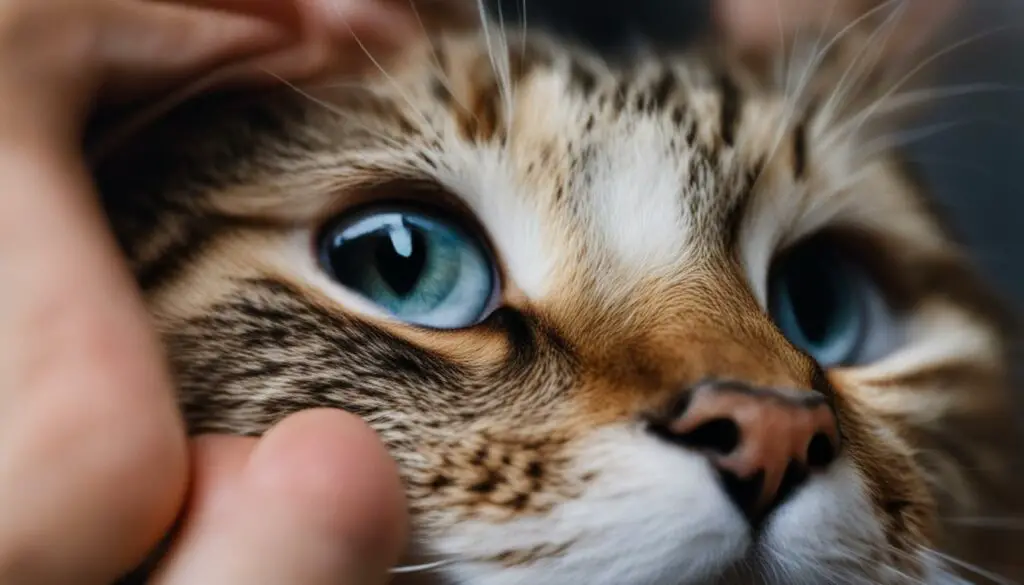
Treatment Options for Hair in the Eye
When it comes to treating hair in a cat’s eye, the approach depends on the underlying cause and the severity of the condition. In mild cases, simple at-home remedies may be sufficient to alleviate the discomfort. This can include gentle eye rinses using sterile saline solution or specialized eye drops to lubricate the eye and flush out any trapped hair particles.
In more severe cases, where the hair is deeply embedded or causing persistent irritation, it is crucial to seek veterinary intervention. A veterinarian may use specialized tools to carefully remove the hair under controlled conditions. This ensures the safety and well-being of the cat while effectively addressing the issue. It is important to note that attempting to remove the hair without proper training or equipment can potentially harm the cat’s delicate eye structures.
For certain breeds or recurring cases, surgical intervention may be necessary. This can involve procedures such as epilation, where hair follicles are removed to prevent further hair growth around the eye area. Surgical options should always be discussed with a veterinarian, who can assess the cat’s specific needs and provide appropriate recommendations.
Preventive Measures
Prevention is key when it comes to managing hair in the eye. Regular grooming and brushing sessions can help minimize the amount of loose hair and reduce the chances of it ending up in the eyes. Trimming the hair around the eyes, especially in long-haired breeds, can also be beneficial in preventing hair from getting trapped. Additionally, keeping the cat’s environment clean and free from potential irritants can further reduce the risk of hair in the eye.
| Treatment Options | Advantages | Disadvantages |
|---|---|---|
| Gentle Eye Rinses | – Easy to administer | – May not be effective for deeply embedded hair |
| Lubricating Eye Drops | – Provides relief from irritation | – Temporary solution, may require frequent application |
| Specialized Hair Removal Tools | – Precise removal of hair | – Requires professional expertise |
| Surgical Intervention | – Permanent solution for recurring cases | – Invasive procedure, potential risks |
Remember, if your cat shows signs of discomfort or irritation due to hair in the eye, it is important to consult with a veterinarian for proper diagnosis and guidance. They will be able to determine the most suitable treatment options based on your cat’s individual needs and ensure their eye health is effectively managed.

Preventing Hair in the Eye
To prevent hair from getting into your cat’s eyes, it’s important to establish a regular grooming routine. Regular brushing helps to remove loose hair and prevents excessive shedding, reducing the chances of hair ending up in the eyes. Use a soft brush or comb to gently groom your cat, paying extra attention to the areas around the eyes.
It’s also beneficial to trim the hair around your cat’s eyes to minimize the risk of hair getting into their eyes. This should be done carefully and with the use of blunt-tipped scissors or clippers specifically designed for trimming cat fur. If you’re unsure about how to safely trim your cat’s hair, consult with a professional groomer or your veterinarian for guidance.
Keeping the area around your cat’s eyes clean is another important step in preventing hair from causing irritation or discomfort. Use a damp cloth or specially formulated pet wipes to gently clean the area around the eyes, removing any debris or excess discharge. Be cautious not to get water or cleaning solutions directly into your cat’s eyes.
By implementing these preventive measures, you can help ensure that your cat’s eyes stay free from hair and minimize the risk of ocular irritation and discomfort.

Seeking Veterinary Care
If your furry friend is experiencing persistent discomfort or showing signs of eye infection or inflammation, it’s essential to seek veterinary care for proper diagnosis and treatment. As pet owners, we may not have the expertise to accurately assess the severity of the condition or identify any underlying issues that could be contributing to the hair in the eye problem.
A qualified veterinarian will conduct a thorough eye examination to determine the extent of the issue and recommend appropriate treatment options. They may perform tests like a phenylephrine challenge to confirm the presence of hair in the eye. With their expertise and specialized tools, they can safely remove the hair if necessary.
Remember, early intervention is key when it comes to eye health. Delaying or neglecting veterinary care can lead to further complications and discomfort for your beloved pet. So, if you notice any signs of eye irritation or suspect your cat has hair in its eye, schedule an appointment with a trusted veterinarian as soon as possible.
By seeking veterinary care, you can ensure that your cat receives the proper treatment and attention needed to alleviate their discomfort and maintain optimal eye health.

Genetic and Breed Considerations
When it comes to hair in the eye, certain genetic factors and breed considerations play a role in a cat’s susceptibility to this condition. While any cat can experience hair in the eye, some breeds may be more prone to it than others. Understanding these factors can help breeders and owners take proactive measures to prevent and manage this issue.
Genetics can influence a cat’s grooming habits and the quality of their hair, which in turn can affect the likelihood of hair ending up in their eyes. Some breeds have longer or thicker hair, which may be more prone to shedding and getting into the eyes. For example, Persians and Maine Coons are breeds known for their luxurious coats, but their long hair can increase the risk of hair in the eye. Additionally, certain breeds may have a predisposition for excessive grooming, which can lead to more hair loss and higher chances of hair in the eye.
Owners and breeders of cats with genetic predispositions should take proactive steps to minimize hair in the eye. Regular grooming and brushing can help reduce shedding and prevent loose hairs from getting into the eyes. Trimming the hair around the eyes can also help reduce the risk. It is important to consult with veterinarians and breeders who specialize in the specific breed to get guidance on grooming practices and preventive measures.

By understanding the genetic and breed factors related to hair in the eye, breeders and owners can ensure that the well-being and eye health of their feline companions are maintained. Taking preventive measures and seeking appropriate veterinary care when needed can make a significant difference in the overall eye health and comfort of cats, regardless of their breed.
Importance of Regular Eye Examinations
Regular eye examinations are vital for maintaining the overall health and well-being of your cat. Just like humans, cats can develop various eye conditions that require prompt attention and treatment. By scheduling regular eye exams with a veterinarian, you can ensure early detection of any potential issues and provide timely intervention.
Cat eye health is a complex matter, and some problems may not be visible to the naked eye. During an eye examination, a veterinarian will thoroughly assess your cat’s eyes, checking for any signs of infection, inflammation, or abnormalities. This thorough evaluation can help identify problems such as hair in the eye, which can cause discomfort and irritation if left untreated.
In addition to diagnosing existing issues, regular eye examinations can also serve as preventive care. The vet can offer valuable advice on maintaining good eye health for your feline companion. They may recommend specific grooming routines, dietary adjustments, or environmental changes that can minimize the risk of eye-related problems, including hair in the eye.
Benefits of Regular Eye Examinations
- Early detection of eye issues
- Prompt treatment and intervention
- Preventive care for long-term eye health
- Expert advice on grooming and dietary practices
- Peace of mind for pet owners
Remember, cats are masters at hiding discomfort, so regular eye examinations play a crucial role in maintaining their well-being. By prioritizing their eye health, you can ensure a happy and healthy life for your feline friend.

Managing Feline Eye Health
When it comes to feline eye health, there are a few key factors to consider. Providing a balanced diet is crucial, as certain nutrients like vitamins A and C, omega-3 fatty acids, and antioxidants play a vital role in maintaining good eye health. Including these nutrients in your cat’s diet can help support overall eye function and reduce the chances of eye-related issues, including hair in the eye.
Grooming practices also play a significant role in managing feline eye health. Regularly brushing and grooming your cat not only helps to prevent excessive shedding but also minimizes the risk of hair getting into their eyes. Additionally, trimming the hair around their eyes can further reduce the chances of hair irritating the delicate eye tissues.
Creating a stress-free environment for your cat is also important for their eye health. Stress can weaken their immune system, making them more susceptible to eye infections and inflammation. Providing a safe and calm space for your feline friend can help reduce stress levels and contribute to their overall eye health.
To ensure the best care for your cat’s eyes, regular veterinary check-ups are essential. A veterinarian can perform thorough eye examinations, identify any potential issues early on, and provide appropriate treatment if needed. Remember, proactive management of feline eye health is key to keeping your cat’s eyes bright, clear, and healthy.
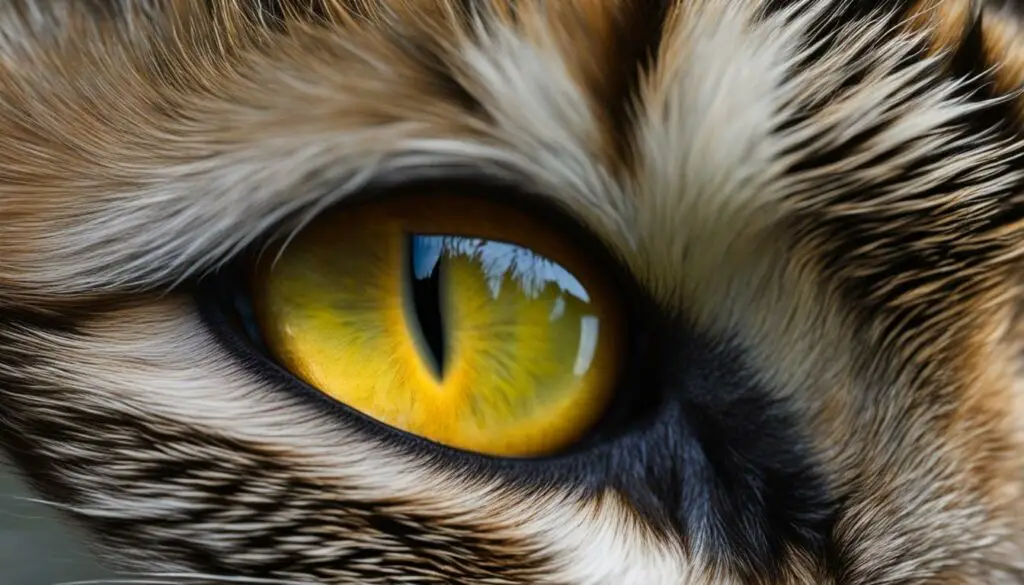
Ensuring a Healthy Vision for Your Cat
When it comes to your cat’s eye health, it’s important to take proactive measures to ensure a healthy vision. By following a few simple cat eye care practices, you can help prevent issues and maintain your furry friend’s visual well-being.
Regular Cleaning
Regularly cleaning your cat’s eyes can help remove any debris or dirt that may cause irritation or discomfort. Use a soft, damp cloth or a gentle eye wipe specifically designed for cats to wipe away any residue around their eyes. Be sure to be gentle and avoid applying excessive pressure, as the eyes are delicate.
Avoid Exposure to Irritants
Cats can be sensitive to environmental factors that can irritate their eyes. Keep your cat away from smoke, strong chemicals, and potential allergens that may cause eye irritation. Additionally, ensure that any cleaning products or substances used around your cat are safe and non-toxic to prevent accidental exposure.

Prompt Veterinary Care
If you notice any signs of discomfort or changes in your cat’s eye health, it is crucial to seek prompt veterinary care. A veterinarian can assess the condition of your cat’s eyes, identify any underlying issues, and provide appropriate treatment or recommendations. Regular check-ups with your vet are also necessary to monitor your cat’s overall eye health.
By incorporating these cat eye care practices into your routine, you can help ensure a healthy vision for your beloved feline companion. Remember, prevention and early detection are key to maintaining the well-being of your cat’s eyes.
Conclusion
In conclusion, feline eye care is crucial for maintaining the overall health and well-being of our furry friends. Hair in the eye can cause significant discomfort for cats and may require prompt veterinary intervention. Understanding the causes, symptoms, and treatment options discussed in this article can help pet owners effectively manage this common issue.
Regular eye care and preventive measures, such as regular grooming and brushing, are essential in preventing hair in the eye. Trimming the hair around the eyes and keeping the area clean can also reduce the risk of this problem. Additionally, seeking veterinary care for persistent discomfort or signs of eye infection is vital to ensure proper diagnosis and appropriate treatment.
By prioritizing feline eye health, we can help ensure a healthy vision for our beloved cats. Providing a balanced diet, maintaining proper grooming practices, and creating a stress-free environment are all important aspects of managing overall eye health. Remember, regular eye examinations by a veterinarian are essential for detecting any potential issues early on and addressing them before they escalate.
So, let’s make feline eye care a priority and take proactive measures to keep our cats‘ eyes healthy. By doing so, we can help our furry companions live their lives to the fullest, free from discomfort caused by hair in the eye and other eye-related issues.
FAQ
What are the symptoms of hair in the eye in cats?
Cats with hair in their eyes may exhibit symptoms such as excessive blinking, rubbing or scratching the affected eye, watery eyes, and potential signs of ocular inflammation.
How is hair in the eye diagnosed in cats?
A thorough eye examination by a veterinarian is essential to diagnose hair in the eye. The vet will evaluate the eye’s condition, check for any underlying issues, and may perform tests like a phenylephrine challenge to confirm the presence of hair in the eye.
What are the treatment options for hair in the eye?
The treatment for hair in the eye depends on the underlying cause and severity of the condition. Options may include gentle eye rinses, lubricating eye drops, or removing the hair with specialized tools under veterinary supervision. In severe cases, surgical intervention may be necessary.
How can I prevent hair from getting into my cat’s eyes?
Regular grooming and brushing can help prevent excessive shedding and minimize the chances of hair getting into a cat’s eyes. Trimming the hair around the eyes and keeping the surrounding area clean can also reduce the risk of hair in the eye.
When should I seek veterinary care for my cat’s hair in the eye?
If a cat is experiencing persistent discomfort or shows signs of eye infection or inflammation, it is crucial to seek veterinary care. A veterinarian can provide a proper diagnosis, recommend appropriate treatment, and ensure the overall eye health of the cat.

